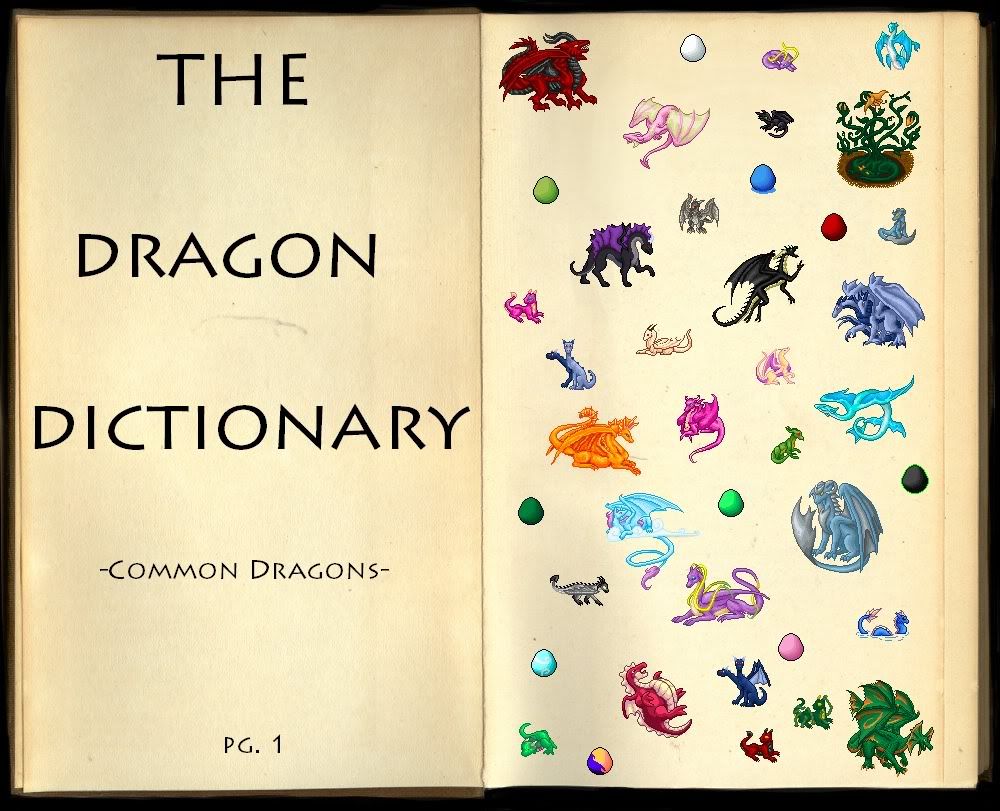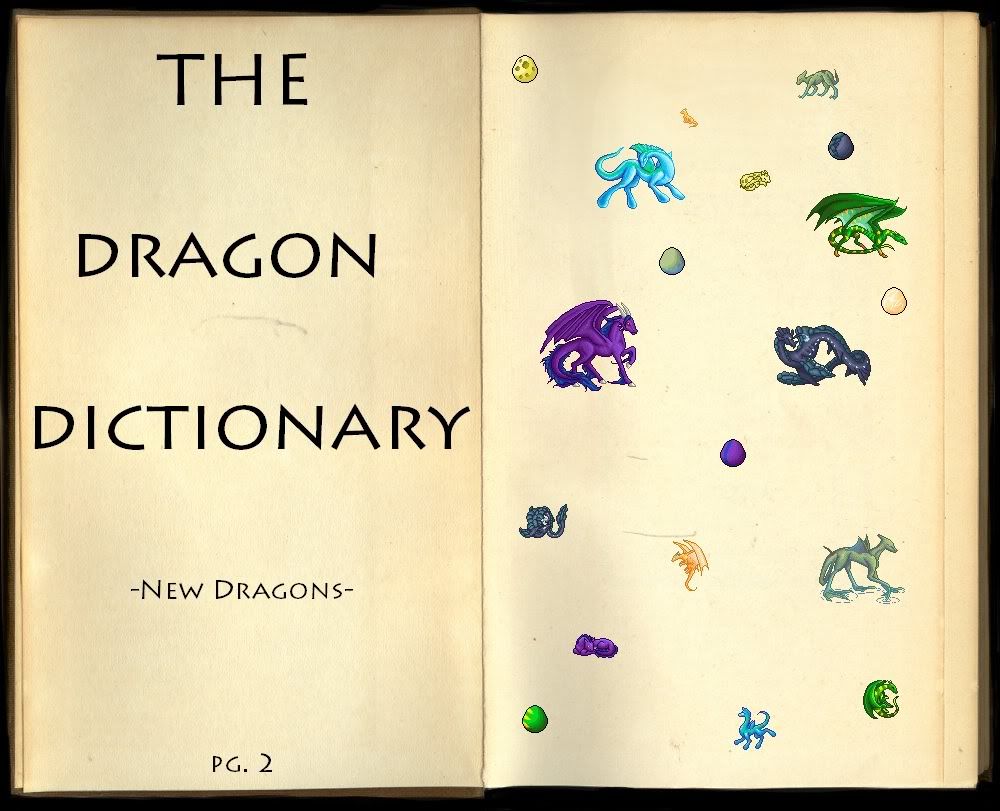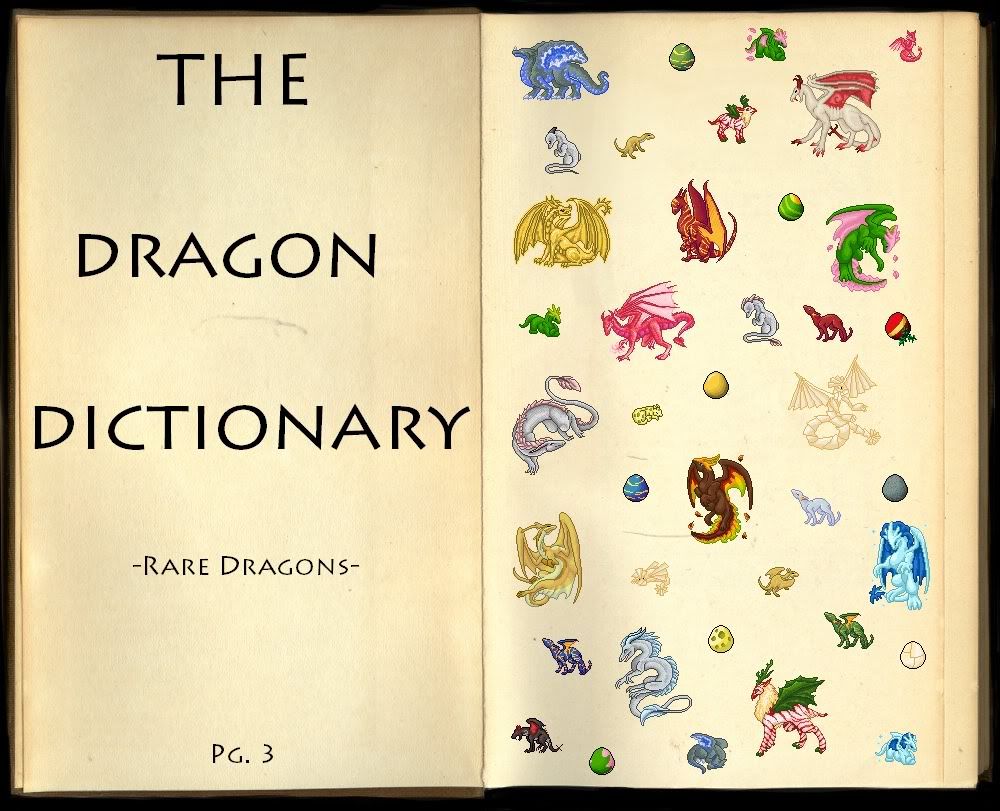|
|
| Readers? |
|
|
| Total Votes : 103 |
|
|
|
|
|
|
|
|
 Posted: Sun Aug 02, 2009 7:40 pm Posted: Sun Aug 02, 2009 7:40 pm
|
|
|
|
|
|
|
|
|
|
 Posted: Tue Aug 04, 2009 7:57 pm Posted: Tue Aug 04, 2009 7:57 pm
~Pg. 1~
"Common Dragons"Albino Dragons
   
Albino dragons are so named because their translucent, scale-less skin lacks all pigment. Instead, to help protect their bodies from the sun, they are coated in an oily secretion that blocks the sun's harmful rays. The call of an albino dragon is similar to a barn owl--a shriek instead of a roar.
Balloon Dragons
   
Balloon dragons are so named because they are filled with a gas that makes them almost lighter than air, similar to balloons. However, they are not prone to "bursting, as they are covered in tough skin and can deflate themselves if necessary. In addition, they generally are slow moving. They use their gas bladders to float to the tops of trees, where food is more abundant. They can shift their weight from their backs to their fronts, allowing them to reach leaves and fruit.
Black Dragons
   
   
Alt. Black Dragons
    
Black dragons are warriors. They are strong and capable in battles of force, but also ample magic users, capable of devastating opponents with their spells. Their bright eyes give them excellent night vision, which is why they generally hunt during the night.
Bright-Breasted Wyverns
   
Bright-Breasted Wyverns are a breed of dragon easily recognized by their bright red markings. They are a small breed, only the size of a full-grown man. However, they have developed poisonous barbs on their feet to make up for their size. Their coloration is used to warn off potential predators of the danger, and is also used to attract mates. They are very social, and can often be seen preening in large groups.
Canopy Dragons
    
Canopy dragons love to soar above the tropical jungles, and other densely forested areas. Their billowing, layered wings create generous lift that allows them to ascend effortlessly over the warm jungle. While their unique wings do not make them the fastest flyers, they are champion gliders. To further this end, dexterity, manueverability, and grace are all judged by the females when selecting their mates from the males that can accurately complete the exhausting and elaborate courtship dance between the close growing branches of the upper canopy.
Coastal Wyverns
   
Coastal Waverunners spend most of their time skimming the waves along the coast, snatching up their prey from the shallow waters. They have developed markings along the leading edges of their body that help disguise them as breaking waves. When they are not hunting, they enjoy playing among sand-dunes and shallow tide-pools. These dragons live in small but noisy rookeries. Some stories say Waverunners can fly for days on end without landing.
Daydream Dragons
   
Daydream dragons are the hosts of daydreams and fantasies. They spend the majority of their time sitting on clouds, dropping daydreams down into the minds of people passing by. Humans who live near daydream dragons must be especially careful not to let their thoughts wander, or they could end up spending hours or even days in a trance-like waking dream state.
Day & Night Glory Dragons
Day Glory
   
Day Glory drakes are radiant and friendly creatures that love the company of humans. They are so friendly, in fact, that they will eat food and treats right from a person's palm.. Despite their friendliness, they aren't an easy target for predators due to their excellent flying abilities; when danger approaches, they are able to vanish within seconds. Breeding only occurs during the day when the sun is warms.
*To breed a Day Glory dragon, you must breed an egg in the morning (according to EST, that is)!*
Night Glory
   
Unlike their dirunal relatives, Night Glory Drakes are shy and reserved. Active during the night, they are often mistaken for bats and chased away from human settlements. With their excellent agility and night vision, they are perfectly adapted to nocturnal life. Breeding only takes place during evenings after the dark settles in.
*To breed a Night Glory, you must breed an egg at night (according to EST!)*
Deep Sea Dragons
   
Deep sea dragons, as their name suggests, spend most of their time in the darkest depths of the sea. They have a bioluminous dorsal spine that serves to attract pray and communicate with their own kind. As with many deep sea animals, they generally eat whatever they can manage to abait. They rarely leave the ocean floor, surfacing only during breeding season. When they do choose to travel to the shallower depths, they avoid bright lights and will only come up far away from shore.
Dorsal Dragons
Purple:    
Red:   
Dorsal dragons are so named because they have large fins along their backs that can be raised and lowered at will. They use these fins to regulate body temperature; they raise them to cool off when they become overheated. The bright colors on the fins double as a means of attracting mates.
Dragon Horses
   
The dragon horse has an equine-shaped body and hooves instead of claws, which allows it to be a very fast runner. It specializes in running takeoffs, which are quicker than takeoffs from a stand-still. The horse dragon is able to stalk its prey from the ground, and then quickly execute an aerial attack for the kill.
Flamingo Dragons
    
Flamingo wyverns are so named for their resemblance to the tropical birds with whom they often share territory. Their most striking feature is the bony black crest over their faces and snouts, smaller in females, aiding both in digging up food and protection from attack. Females are noticeably brighter than males due to their habit of not straying far from particularly algae-rich feeding grounds.
Frill Dragons
   
Frilled dragons are smaller than most other breeds, but when threatened, they stretch out their wings and frills to appear larger. They generally do not like to fight, and prefer hiding to confrontation. Frilled dragons live in small groups and often band together to scare off potential threats. Males also use their frills as a way to attract mates, with those displaying the "best" frills being more likely to breed.
Electric Dragons
   
As their name suggests, Electric dragons are capable of producing electric charges. They can produce different amounts of electricity depending on their mood and time of year. During mating season, their sparks become brighter to attract potential mates. Electric dragons aren't usually a danger to other dragons, but they do use their power to attack predators and prey.
Gray Dragons
     
Gray dragons are the masters of the skies. They are excellent fliers, and land only to rest and eat. In addition, they have full control of the weather. They are very hot-tempered and easily angered. They will attack any human that bothers them, conjuring strong winds and dangerous lightning.
Green/Earth Dragons
   
Green dragons are also sometimes called "earth" dragons. They usually live deep within caves, and have power over the earth. They are capable of launching boulders at high speeds, and can cause earthquakes by slamming down onto the ground.
SPECIAL ABILITY - EARTHQUAKE: Gives all of your eggs a chance to hatch early, with the risk of accidentally killing them instead.
Guardian Dragons
    
Every guardian dragons has a large shield on the end of their tail. Although the shields appear to be heavy, they are light, yet nearly unbreakable. Guardian dragons use their tail-shields, as well as their wings, to deflect attacks and protect others. Often, they will guard the eggs and hatchlings of a nest while others are away. They are generally peaceful, and will not retaliate unless necessary. They have no need to forage or hunt, as they are fed by those they protect.
Harvest Dragons
     
Harvest dragons are a large, flightless breed most often found in heavily forested mountains. Normally shy, these omnivorous dragons keep to themselves in remote regions, but in the fall they descend from their high territory to search for food—and lots of it. During the autumn months, harvest dragons will eat whatever they can find, from large and small animals to nuts and fruit. In the winter they retreat into large caves and hibernate until spring, living off the fat they have built up.
Magi Dragons
   
Magi dragons are, as their name suggests, primarily magic users. They rarely use physical forms of attack. They eat anything they can kill, which is generally everything. They won't kill unprovoked except when hunting, although they may kill humans if in danger. Their strong magic makes them one of the most feared breeds of dragons.
Mint Dragons
   
Mint colored dragons are the most peaceful of all dragons; they only eat plants unless they scavenge meat from an already dead animal. They also have no ways to attack others or defend themselves. They are much smaller than other forms of dragons, since they only double in size when they mature. Mint dragons are unable to use magic, and cannot fly since they don't have wings. Their looks have given rise to the common insult of calling dragons "large lizards."
Neotropical Dragons
   
Neotropical dragons are a breed that originate in rainforests. They are fun-loving and enjoy lounging on tree branches, eating whatever fruit they find. They are also often found sunning themselves on rocks, using their large wings to soak up the rays. In the summer, males compete for mates by showing off their striped wings, gliding in spirals down the tree trunks. It is said that the larger the wings, the more likely the male will attract a suitable mate.
Bright Pink Dragons
   
Bright pink dragons are one of the few all-female breeds of dragons. Their bright colors make them easy to spot during dragon mating season. They are primarily herbivores, but eat meat during mating season when it is brought to them by a mate. Mating seasons occur once every 200 years and can last up to 2 years.
Pink Dragons
    
Pink dragons are primarly herbivores, and only eat meat during the mating season, when mates will exchange kills. When it is not breeding season, pink dragons spend most of their time incubating eggs and caring for their clan's young. Due to their feminine color, it was traditionally thought that pink dragons were a strictly female breed, but this is not true.
SPECIAL ABILITY - INFLUENCE: Increases the chance of an egg of your choosing being a male/female, depending on the gender of the dragon doing the influencing.
Purple Dragons
     
Purple dragons are one of the few all-female breeds of dragons. Their bright colors make them easy to spot during dragon mating season. They are primarily herbivores, but eat meat during mating season when it is brought to them by a mate. Mating seasons occur once every 200 years and can last up to 2 years.
Pygmy Dragons
     
Pygmy dragons are the smallest breed of true dragons, being the size of a small cat. They are often found around concentrated populations of dragons, relying on their larger brethren to ward away potential predators, and to leave generous scraps. As such, the majority of a Pygmy's diet is scavenged, though they do hunt songbirds and small mammals when the pickings are slim. Due to their tiny size, pygmies do not breed with other varieties of dragons, but select mates within their breed.
Red Dragons
   
Red dragons are similar to typical story book dragons. They shoot flames, can fly, etc. However, they aren't evil creatures as depicted in myths, and won't go around raiding castles, killing knights, or kidnapping princesses. They live in a variety of habitats, from forests to coastlines to abandoned castles, usually in warm climates, and eat whatever living creatures they can find.
SPECIAL ABILITY - INCUBATE: Warm an egg, allowing it to hatch faster.
Ridgewing Dragons
    
    
Ridgewing dragons live just below the snow level on the upper slopes of mountains. They are a friendly, playful breed and enjoy dancing in wind currents near their homes or plummeting down into valleys from great heights. Their wings, by far their most striking feature, grow in fin-like ridges along their backs. While their bodies lack markings to blend better with their surroundings, a ridgewing's wings have bright markings in the colors of the flowers that grow in their mountain habitat. Occasionally different-colored individuals can be found, but they are rare because their striking coloring offers little protection.
Shallow Water Dragons*
    
Shallow Water dragons are found in tropical regions where the water is warm. They use their magic to hunt, using bubbles to capture small fish and animals. Their large, webbed feet make them excellent swimmers and they are able to move at very high speeds. Due to their bright colour, these dragons are easily spotted in the lagoons where they live.
SPECIAL ABILITY - SPLASH! ... But nothing happened.
*To breed... Water Dragon x Magi Dragon
Skywing Dragons
   
Skywing dragons spend most of their lives flying in the air. They hunt from the air, diving at prey from above, and land only to rest. They are one of the fastest fliers, capable of extremely high speeds. The webbing at the end of the tail acts as a rudder, allowing them to easily change direction during flight.
Spitfire Dragons
   
Spitfires are a desert breed of dragon. Their dull brown bodies contrast with their brilliant turquoise markings, and they only blaze brighter when these dragons fight. Spitfires are notorious for for their territorial natures, and the wing-edges of most are ripped and tattered before their first year is out. Spitfires are also noteworthy for their brilliant blue fire, which is used not for hunting or fighting, but rather for making glass caves from the sand, in which the dragons can soak up the sun.
Stone Dragons
   
Stone dragons have a tough outer covering made of a stone-like material. They eat rocks, using the minerals they contain for nourishment and to keep up their stone outer shell. They rarely move, and are the heaviest of all types of dragons. Although they have wings, indicating flight ability, no one has ever seen a stone dragon flying.
Sun Dragons

Sunrise:   
Sunset:   
Sunrise dragons are closely related to sunset dragons. However, their behaviors differ greatly. Sunrise dragons prefer to live in large groups, and enjoy basking in the early morning sun. They are usually most active in the morning, and go to sleep in the early evening.
Sunset dragons are closely related to sunrise dragons. However, their behaviors differ greatly. Sunset dragons generally live alone or in small packs. They are more active in the evening, hunting and performing all of their daily tasks as the sun sets.
*Sunrise dragons will hatch from a sun egg in the morning, and Sunset dragons will hatch from a sun egg in the evening!*
Sunsong Dragons
     
Sunsong Amphipteres are an unusual species. Due to light interference caused by their magical nature, they don't seem to be affected by any ambient light source. However, when struck by direct sunlight, they shine a brilliant gold. They are playful and ever in flight; their ethereal and mysterious appearance and the fact that they are usually only seen at a distance have led many to believe they are a symbol of hope and good fortune.
Terrae Dragons
       
Terrae dragons are primarily herbivores who prefer to eat from the tops of trees. However, due to their massive size, they must rely on small, specialized scales to absorb and convert energy from the sun. Since they live in tightly-knit groups, this form of energy absorption helps preserve the forests in which these dragons reside.
Two Headed Dragons
 
Female: 
Male: 
Two headed dragons are a special breed of dragons. They have two necks, two brains, two mouths, but one stomach and one main body. The two heads usually work together, but there are times when they will fight each other, attacking back and forth. They use their sharp teeth and wings to hunt large animals, and rarely eat plants. It is unknown what would happen if a two headed dragon were to mate with a one headed dragon, since it has never occurred. They only mate within their breed.
Vine Dragons
   
Alt Vine Dragons
  
Dark green dragons, once they mature, appear to become an entirely different species. However, this isn't true. Rather, they burrow underground and get nutrients from their vines. These vines are sometimes referred to as Dragon Grass. These dragons are very violent, and will use their vines to capture, kill, and eat anything that moves, as well as nearby plants. Luckily, their range is limited, and they cannot use magic. Dark green dragons tend to be easy to spot since they usually kill all plants around them and thus are usually surrounded by a large clearing.
Water Dragons
     
When water dragons mature, they lose their legs and the ability to survive on land, entering the water permanently. They are adept swimmers and eat whatever fish are in the lake they live in. They usually stay in the same lake for their entire life, although a few live in the ocean and swim all over the world.
Waterhorse Dragons
    
Waterhorse dragons received their name due to their horse-like physique and endearing behavior. They are capable of surviving out of water, and when on land their skin secretes a gelatinous goo to retain moisture. However, their large paddle feet are better suited for swimming, and waterhorse dragons tend to move very awkwardly when on land. Waterhorses are very friendly dragons, and enjoy playing with humans.
Water Walkers
   
Water walkers are small dragon that are frequently found around bogs and ponds. While they are flightless, they retain the flight sacs and hollow bones of their airborne cousins. These traits, coupled with their extraordinarily long, webbed toes, allow them to stand on top of calm waters, using their small sails propel them wherever they please. They spend the majority of their life on the water, retreating to the tops of lily pads when the waters become too rough to float atop.
Whiptail Dragons
   
Feisty and energetic, whiptail dragons pride themselves on their speed and agility. It is not unusual to see several whiptails racing each other. Though fragile, they can easily evade attacks with their superior speed, and often use their long tails as a weapon, giving rise to their name.
White Dragons
   
White dragons are pacifists, and specialize in extremely strong healing magic. The only limit of this magic is that it can't bring back the dead. They only eat plants, and never kill living things.
|
 |
 |
|
|
|
|
|
|
|
|
|
|
|
|
|
|
|
 Posted: Wed Aug 05, 2009 8:54 am Posted: Wed Aug 05, 2009 8:54 am
~Pg. 2~
"New Dragons"**(will be updated along with updates to the DC)Updated November 14th, 2010
~Under Construction~
Black Streak
   
Striped dragons come in a dazzling array of colors complemented by an intricate pattern of stripes. These bright colors and patterns help attract their favorite food, insects. Because their prey is so tiny, striped dragons must spend a large portion of their day eating. The color of the offspring is usually determined by the dragon's mate.
Pillow
     
Pillow Dragons are covered in enormous emounts of fur affectionately referred to as fluff. Despite their deceivingly large size, they can still fly even with such tiny wings because their bodies are remarkably light. Pillow dragons have a habit of sleeping for up to eighteen hours a day, waking only in short bursts. During their few waking hours, they take the time to hunt for prey. Once a pillow dragon becomes an adult, its fur grows very slowly. Pillow dragon fur is used to make very expensive and valuable cloth known as "dragon cashmere."
Swallowtail
     
Swallowtail dragons are graceful and quick flyers, much like their namesake bird. They are capable of precise arial acrobatics, and can reach very high altitudes. Because of this, humans observing these dragons are often astonished at how large they are when confronted up close. A Swallowtail's diet consists of insects and small mammals plentiful in temperate forests. These dragons are also made remarkable by their paperthin wing membranes, which allow light to pass through, creating an astonishing effect on starry nights.
Alt Nebula
 
 
Nebula dragons are nocturnal creatures. With the best eyesight to be found, they are often seen staring into space. Each dragon tends to observe a particular nebula and will eventually change their colors and patterns to match it. As the nebula changes over time, the dragon changes with it. The more intricate the design of the nebula, the better chance an individual has of attracting a mate. It is said that the markings on no two Nebula dragons will be exactly the same.
|
 |
 |
|
|
|
|
|
|
|
|
|
|
|
|
 Posted: Sun Aug 09, 2009 6:59 pm Posted: Sun Aug 09, 2009 6:59 pm
~Pg. 3~
"Rare Dragons"
Black Marrow Dragons
    
Black Marrows are named for their dark colored hides which are encased in a distinct exoskeleton. Their skull and the top edges of their spine push out from under the skin as they age. As such, their young need excessive amounts of protein for this armor to develop. The older a Black Marrow dragon is, the more skeletal their appearance. They often use their skeletal looks to lure in foolish scavengers or terrify predators. These vicious dragons love nothing more than to crack open bones with their stony beaks and eat the marrow inside. Voracious scavengers, Black Marrows will swarm and devour corpses both old and fresh, sometimes even dragging larger finds to the water to allow them to "ripen". Despite their dreadful demeanour and often horrid stench, Black Marrows are devoted mates and parents.
Cheese Dragons
   
Cheese dragons are not actually alive. They are enchanted items of food that act almost identically to dragons. They have no need to eat, but they must 'live' in humid environments or they will dry out and harden.
Christmas Dragons
Holly Dragons
  
Yulebacks
   
Cheer Dragons
   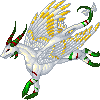 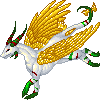 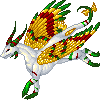
Ribbon Dancers
   
Christmas dragons are a very mysterious breed. They are only seen during winter, and even then it is hard to catch a glimpse of one. They are responsible for the general cheer that spreads during the holidays. In essence, they are the 'Spirits of Christmas.'
Ember Dragons
    
Ember dragons have a great affinity for hot environments. While they themselves are not hot to the touch, their tendency to lurk amongst smoldering ashes has caused many to believe they are fire-starters. Their dully glowing markings serve many purposes; acting as a means of identification between individuals, as an important part of mating displays, and as a way of showing aggression. The long, low build of the breed makes them ungainly in flight, and the thick fleshy membranes of their wings hinder them further. As such, it is rare to see an ember dragon take to the air. Ember dragons are also not particularly sociable; females tend to be defensive, whereas males are more aggressive. Once they have settled with a particular group dragons, ember dragons are increadibly loyal and will defend their pack with any means possible.
Geode Dragons
    
Geode dragons are closely related to Stone dragons. They are covered in a hard stone-like material, as well as beautiful crystal. Their wings are entirely useless for flight, but they help attract mates. The dragons with the most brilliant and colorful crystals are more likely to mate.
Gold Dragons
   
Gold dragons are the ones most often killed by humans, who consider their scales to be extremely valuable. These golden scales grant them a high level of protection, similar to armor, and they use this to their advantage in battle.
Hellfire Wyvern
   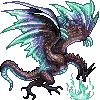
Hellfire Wyverns are so named for their foul tempers and fiery visages. Their social structure places all females above all males, due to superior physical characteristics and violent dispositions. Forced subservience of the males causes them to become vicious, petty, antisocial, and passive-aggresive compared to the aggressive and social females. However, orphaned hatchlings raised by foster parents of another species can develop surprisingly even tempers and mellow dispositions, proving that their defining unpleasant nature is, in fact, a learned behavior.
Ice Dragons
   
Ice dragons are fierce predators who hunt using their extremely cold breath. The breath of an ice dragon can freeze its prey solid in seconds. The body of an ice dragon is so cold that icicles will form along its skin no matter the outside temperature.
Magma Dragons
   
Magma dragons are capable of withstanding the intense temperatures of their element. They live in volcanic regions, their bodies coated in the red hot magma which clings to their scales. They must leave the lava fields in order to hunt, requiring surprisingly little food to sustain their lumbering mass.
Nebula Dragons
    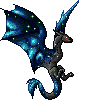 
   
Nebula dragons are nocturnal creatures. With the best eyesight to be found, they are often seen staring into space. Each dragon tends to observe a particular nebula and will eventually change their colors and patterns to match it. As the nebula changes over time, the dragon changes with it. The more intricate the design of the nebula, the better chance an individual has of attracting a mate. It is said that the markings on no two Nebula dragons will be exactly the same.
Neglected Dragons
  
-More info coming soon-
Nocturne Dragons

Day:   
Night:    
Pumpkin
   
Seasonal Dragons
Spring   
|
 |
 |
|
|
|
|
|
|
|
|
|
|
|
|
|
|
|
 Posted: Sun Aug 09, 2009 7:32 pm Posted: Sun Aug 09, 2009 7:32 pm
~Pg. 4~
"Wait, These Aren't Dragons!"Chickens
  
Well, your "pet" chick grew up into a chicken, but you're still not sure how the egg got into that cave...
Dinos
    
You were right, it's not the same species as the other eggs. So if it's not a dragon, what is it?
  
  
  
  
  
Finally, after much feeding, your baby has grown into a full Dino! Dinos can eat almost anything, including things with spikes. In order to do so, they must have very tough stomachs. Green Dinos are the only type of Dino that is able to walk on two legs. This frees up their front two legs, which they use to catch and eat fish. Yellow Dinos have very long necks, which they use to reach and eat food located high off the ground. Purple dinos are the only breed of dinos that are capable of flight, thanks to their wings.(Note: Only Green, Yellow, and Purple Dinos have additional information about them. Red and Blue do not.)Leedle Trees
 
|
 |
 |
|
|
|
|
|
|
|
|
|
|
|
|
 Posted: Thu Sep 03, 2009 9:13 pm Posted: Thu Sep 03, 2009 9:13 pm
Coming soon... Eggs and Descriptions!           This egg is a third the size of the other eggs. - chicken This egg looks like it doesn't belong, since it has brightly colored spots. It's much lighter than the other eggs. - blue dino This egg looks like it doesn't belong, it is brightly colored with white spots. - green dino This egg looks like it doesn't belong, it is brightly colored with white spots. It's much warmer than the rest of the eggs. - red dino This egg looks like it doesn't belong, it is brightly colored with white spots. It's much heavier than the other eggs. - yellow dino This egg is so tiny you almost didn't see it. - pygmy This egg is a third the size of the other eggs. - chicken  You can see the baby dragon curled up inside this translucent egg.  This light egg is floating in the air.  This egg has a faint green glow around it.  This egg is sitting on a cloud.  This egg appears to be covered in scales.   This egg has multiple bands of color on it.     This egg has strange markings on it.  This egg is surrounded by fog.  This egg is sitting in a pile of small pebbles.  This egg is sitting in front of the others.  This egg has an orange aura radiating from it.  This egg is hidden behind the others, as if it is shy.  This egg has strange yellow stripes.   It's bright. And Pink.  Wow, purple isn't a color of egg you expected to see.  This egg is so tiny you almost didn't see it.  This egg is rather warm.   This egg is heavy and rough, as if it were made out of rock.  This egg is glowing as brightly as the sun.  This egg is split right down the middle into two colors.  This egg is sitting in a patch of grass and small flowers even though there's no sun in the cave.  This egg is sitting on a small puddle.  This egg is slimy and blue.  This egg seems to be floating on a puddle.  This egg shakes from time to time, as if it is eager to hatch.  Electric sparks dance across the surface of this egg.  This egg has icicles forming on it.  This egg is almost too hot to touch.  Whenever you go near this egg your hair stands on end.  This egg appears to be made of limestone.  This egg has colored speckles on it.  This egg is soft and smells uncannily like cheese.  This egg is very reflective, almost metallic looking.  This egg gives off a beautiful glow.     This egg has brightly colored markings on it.  This egg is tiny and made out of several pieces of paper folded together.  This egg smells rotten and is stone cold.    The markings on this egg match the weather outside. ~*~Holiday Eggs~*~ ((You can only get these eggs at certain holidays))  This egg has a holly leaf stuck to it.  -need description-  This egg fills you with holiday cheer.  This egg smells like the autumn harvest.  This egg is speckled and very fragile.
|
 |
 |
|
|
|
|
|
|
|
|
|
|
|
|
|
|
|
 Posted: Thu Sep 03, 2009 9:32 pm Posted: Thu Sep 03, 2009 9:32 pm
~Pg. 3~
"Rare Dragons"
Black Marrow Dragons
    
Black Marrows are named for their dark colored hides which are encased in a distinct exoskeleton. Their skull and the top edges of their spine push out from under the skin as they age. As such, their young need excessive amounts of protein for this armor to develop. The older a Black Marrow dragon is, the more skeletal their appearance. They often use their skeletal looks to lure in foolish scavengers or terrify predators. These vicious dragons love nothing more than to crack open bones with their stony beaks and eat the marrow inside. Voracious scavengers, Black Marrows will swarm and devour corpses both old and fresh, sometimes even dragging larger finds to the water to allow them to "ripen". Despite their dreadful demeanour and often horrid stench, Black Marrows are devoted mates and parents.
Cheese Dragons
   
Cheese dragons are not actually alive. They are enchanted items of food that act almost identically to dragons. They have no need to eat, but they must 'live' in humid environments or they will dry out and harden.
Christmas Dragons
Holly Dragons
  
Yulebacks
   
Cheer Dragons
     
Ribbon Dancers
   
Christmas dragons are a very mysterious breed. They are only seen during winter, and even then it is hard to catch a glimpse of one. They are responsible for the general cheer that spreads during the holidays. In essence, they are the 'Spirits of Christmas.'
Ember Dragons
    
Ember dragons have a great affinity for hot environments. While they themselves are not hot to the touch, their tendency to lurk amongst smoldering ashes has caused many to believe they are fire-starters. Their dully glowing markings serve many purposes; acting as a means of identification between individuals, as an important part of mating displays, and as a way of showing aggression. The long, low build of the breed makes them ungainly in flight, and the thick fleshy membranes of their wings hinder them further. As such, it is rare to see an ember dragon take to the air. Ember dragons are also not particularly sociable; females tend to be defensive, whereas males are more aggressive. Once they have settled with a particular group dragons, ember dragons are increadibly loyal and will defend their pack with any means possible.
Geode Dragons
    
Geode dragons are closely related to Stone dragons. They are covered in a hard stone-like material, as well as beautiful crystal. Their wings are entirely useless for flight, but they help attract mates. The dragons with the most brilliant and colorful crystals are more likely to mate.
Gold Dragons
   
Gold dragons are the ones most often killed by humans, who consider their scales to be extremely valuable. These golden scales grant them a high level of protection, similar to armor, and they use this to their advantage in battle.
Hellfire Wyvern
   
Hellfire Wyverns are so named for their foul tempers and fiery visages. Their social structure places all females above all males, due to superior physical characteristics and violent dispositions. Forced subservience of the males causes them to become vicious, petty, antisocial, and passive-aggresive compared to the aggressive and social females. However, orphaned hatchlings raised by foster parents of another species can develop surprisingly even tempers and mellow dispositions, proving that their defining unpleasant nature is, in fact, a learned behavior.
Ice Dragons
   
Ice dragons are fierce predators who hunt using their extremely cold breath. The breath of an ice dragon can freeze its prey solid in seconds. The body of an ice dragon is so cold that icicles will form along its skin no matter the outside temperature.
Magma Dragons
   
Magma dragons are capable of withstanding the intense temperatures of their element. They live in volcanic regions, their bodies coated in the red hot magma which clings to their scales. They must leave the lava fields in order to hunt, requiring surprisingly little food to sustain their lumbering mass.
Nebula Dragons
     
   
Nebula dragons are nocturnal creatures. With the best eyesight to be found, they are often seen staring into space. Each dragon tends to observe a particular nebula and will eventually change their colors and patterns to match it. As the nebula changes over time, the dragon changes with it. The more intricate the design of the nebula, the better chance an individual has of attracting a mate. It is said that the markings on no two Nebula dragons will be exactly the same.
Neglected Dragons
  
-More info coming soon-
Nocturne Dragons

Day:   
Night:    
Pumpkin
   
Seasonal Dragons
Spring   
|
 |
 |
|
|
|
|
|
|
|
|
|
|
|
|
 Posted: Thu Sep 03, 2009 9:35 pm Posted: Thu Sep 03, 2009 9:35 pm
Haha, the thread was locked... but you can all vote now... ^^' Whoops...
|
 |
 |
|
|
|
|
|
|
|
|
|
 |
|
|
|
|
|
|

